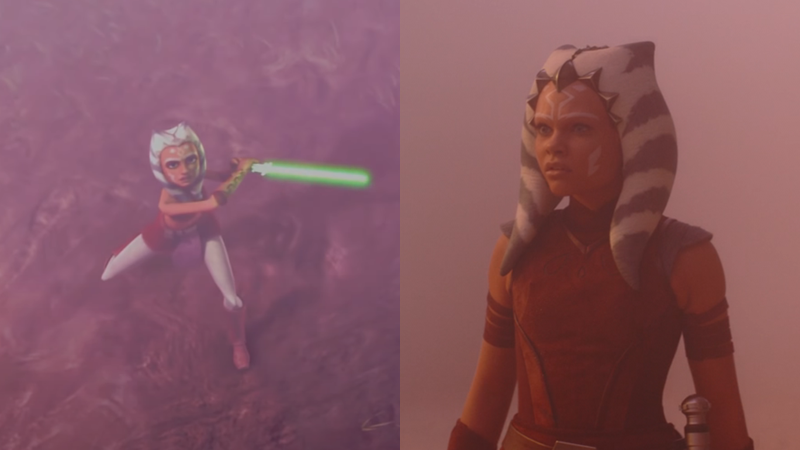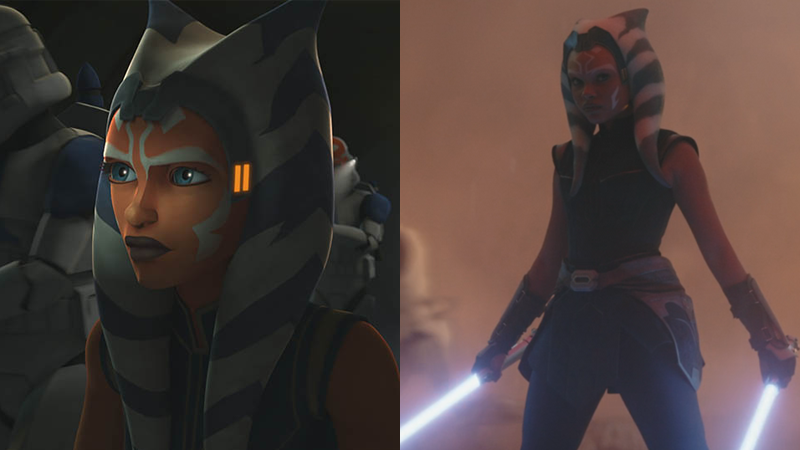Ahsoka’s fifth episode, “Shadow Warrior,” puts its titular protagonist back into her own past, as she navigated her history at the front line of the Clone War. In doing so, we and Ahsoka alike are pressed back into 3 crucial moments from the war—conflicts from her past that still resonate as moments fundamental in exploring who she is as a character.

Although hidden through the haze of memory and the literal fog of war, “Shadow Warrior” divides its flashbacks into three distinct battles from the Clone Wars animated series—ones that, through that fog, are hard to see. But defining each, and where in Clone Wars they came from, tells us the moments that are vital in our understanding of Ahsoka’s past—and where she sees herself as the presence of her former master Anakin pushes her to consider a new path.
The Battle of Teth

Ahsoka’s first flashback takes us to Teth—and back to the original 2008 Clone Wars movie. Although Anakin and Ahsoka met during the battle on Christophsis, Teth, where they are on a mission to besiege a mountaintop fortress where the Separatists are holding Jabba’s son Rotta hostage for… well, reasons. It’s a visually exciting moment in the movie—similar to Ahsoka, it begins shrouded in fog as the Republic takes fire on the ground, as Anakin and his new Padawan vertically ascend the cliff face to complete their mission, massive walkers climbing and clones rappelling up behind them in tow.
But that’s not the point Ahsoka is making bring its hero back to this moment. It’s not just Ahsoka’s first proper mission as Anakin’s padawan—the arrival of who has already created a great deal of conflict for Anakin, unsure of his capacity as a teacher—it’s also the first time we see Ahsoka thrust onto the front line of a war. And what Ahsoka really captures that the Clone Wars movie, and animated series for the most part, couldn’t always quite effectively do so is that, in giving us 16-year-old actress Ariana Greenblatt as the padawan learner, we really get to see how young Ahsoka was when the Clone War breaks out. This is a formative moment for her in establishing her relationship with Anakin, but it’s also arguably the moment she changes as a person forever for altogether worse reasons, exposed from the life she lead as Jedi initiate and transformed into a weapon on the front lines of interstellar conflict.
The Liberation of Ryloth

The next flashback takes us to the climax of The Clone Wars’ first season, and the liberation of the Twi’lek homeworld Ryloth. Although we never see Anakin and Ahsoka participate in the ground battle on Ryloth, the episode “Storm Over Ryloth” sees Anakin and Ahsoka’s mission to break the blockage around the planet, and another important least that is reflected on in Ahsoka as we see her tending to a wounded trooper.
“Storm” sees the Republic beat back by the Separatists’ navy over Ryloth, and after an overconfident Ahsoka disobeys a retreat order, she ends up losing most of her fighter squadron. The moment is devastating for her not just for the loss of life—although even at this early point in the show she’d already seen plenty of soldiers die—but because it’s the first time Ahsoka really has to grapple with losing people under her command, because of a decision she makes. It’s a reckless one for her to make, but once again it cannot be stressed enough as Ahsoka itself makes clear in its casting: she is a child navigating these moments in a war infinitely bigger than she is, and thrust into a role she never expected to have. Relaying that cost here, showing us her tending for a soldier she has to leave behind lest more of those around her are wounded as he is, really hits home just how actually wild Ahsoka’s upbringing was.
The Siege of Mandalore

The third and final flashback skips through most of the rest of Clone Wars to pull us into the final episodes of its seventh and final season: the Siege of Mandalore. This is important as a contrast to Ryloth and Teth because it’s not just an older Ahsoka, one who has at this point well and truly been forged in the fires of the conflict, but because it’s also after Ahsoka had left the Jedi Order in disillusionment. We see the fruits of all those prior lessons here that had shaped Ahsoka, as she spins and twirls around the misty battlefield with her lightsabers: she is, as Anakin’s spirit tells her, the warrior he taught her to be.
But it’s also arguably Ahsoka at some of her most conflicted, and those cracks emerge when her older self, in her young body, begins to poke and prod at the lesson Anakin is trying to teach her. Who is he, the fallen Chosen One, to tell her about the need to grow beyond this conflict? Who is he to lecture, after the Jedi so utterly broke her faith that she had to leave the only home she could remember—and still found herself unable to escape the war that defined her childhood, and still continues to define her decades later? Mandalore is a fundamental moment in Ahsoka’s arc, not just showing us the person she became after choosing to leave the Jedi Order, but for how the Clone Wars ultimately tried to consume her sense of self—and how in moments of weakness she can still find herself back in those moments, even by the time of Ahsoka.
Want more entertainment news? Check out when to expect the latest Marvel, Star Wars, and DC releases, what’s coming to cinemas in Australia this year, and everything streaming this month across all platforms. Check out our dedicated Entertainment tab for more.
